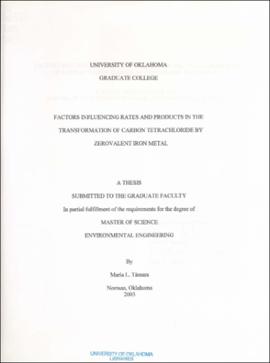| dc.contributor.author | Tamara, Maria L. | |
| dc.date.accessioned | 2022-08-29T17:00:16Z | |
| dc.date.available | 2022-08-29T17:00:16Z | |
| dc.date.created | 2003 | |
| dc.date.issued | 2003 | |
| dc.identifier.uri | https://hdl.handle.net/11244/336513 | |
| dc.description | Thesis (M.S.)--University of Oklahoma, 2003. | |
| dc.description | Includes bibliographical references (leaves 87-94). | |
| dc.description.abstract | Batch experiments were conducted to study the influence of iron purity and
solution chemistry, i.e., pH and common groundwater species such as HS-, HCO3- and
Mn(II), on the anaerobic degradation of carbon tetrachloride (CT) by iron metal (Fe0) . CT
degradation experiments by four commercial irons at pH values of 7 and 9.3 indicated
that iron purity and extent of oxidation affect the rate of CT transformation. In contrast,
the product distribution was not significantly affected by iron purity, with chloroform
(CF) being the major product in all cases. Surface area normalized rate constants (kobs,sA),
backscattered electron images, and elemental composition analysis of the untreated
metals indicate that the highest purity and least oxidized Fe0 was the most reactive in
transforming CT. High pH values slowed the rates of CT disappearance by Peerless Fe0
and led to a pattern of decreasing CF yields as the pH increased from 7 to 12.9. The Fe/O
atomic ratio vs depth, obtained by depth profiling analysis with X-ray photoelectron
spectroscopy (XPS), for Peerless Fe0 filings equilibrated at pH 7 and 9.3 suggested that
the oxide layer is thicker at pH 9.3 , which may explain the slower rates of CT
transformation as pH increases. Ground water constituents such as HS-, HCO3- and
Mn(II) affected the rates of CT by a high-purity Fe0, but did not strongly influence
product distribution, except for HS-, where less CF was produced, possibly due to the
formation of carbon disulfide (CS2). The results have practical implications for in situ
remediation of groundwater contaminated with chlorinated organic compounds by iron
permeable reactive barriers. | |
| dc.format.extent | xi, 116 leaves | |
| dc.format.medium | xi, 116 leaves : ill. (some col.) ; 29 cm. | |
| dc.language.iso | eng | |
| dc.subject.lcsh | Carbon tetrachloride | |
| dc.subject.lcsh | Sewage--Purification--Anaerobic treatment | |
| dc.subject.lcsh | Groundwater--Purification | |
| dc.subject.lcsh | Groundwater--Pollution | |
| dc.title | Factors influencing rates and products in the transformation of carbon tetrachloride by zerovalent iron metal | |
| dc.type | Text | |
| dc.contributor.committeeMember | Nanny, Mark A. | |
| dc.contributor.committeeMember | Sabatini, David A. | |
| dc.contributor.committeeMember | Butler, Elizabeth C. | |
| ou.group | School of Civil Engineering and Environmental Science | |
